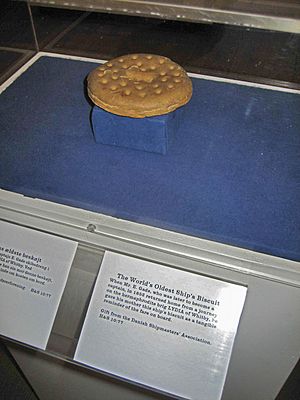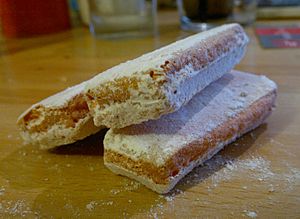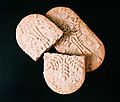Biscuit facts for kids
A biscuit is a type of baked food made mostly from flour. The word "biscuit" means different things in different parts of the world. In North America (like the United States and Canada), a biscuit is usually a soft, fluffy, quick bread that rises while baking. This article focuses on the other kind of biscuit, which is typically hard, flat, and doesn't rise much. This type is common in the Commonwealth of Nations (like the UK, Australia, and India) and Europe.
Contents
Where Did the Word Come From?
The word "biscuit" comes from the Old French word bescuit. This word itself came from the Latin words bis (meaning "twice") and coquere (meaning "to cook"). So, "biscuit" literally means "twice-cooked."
Biscuits were originally cooked twice. First, they were baked, and then they were dried out in a slow oven. This made them very hard and long-lasting. This idea of a hard, twice-baked product came into English in the 14th century.
Around the same time, the Dutch language used the word koekje ("little cake") for a similar hard, baked item. The main difference was that a koekje (which is where the word "cookie" comes from) usually rises when baked, while a traditional biscuit often doesn't, as it has no raising agent.
When Europeans moved to North America, the words "biscuit" and "cookie" (or "cracker") started to get mixed up. In American English, a "cookie" is a small, flat, or slightly raised cake. A "biscuit" can mean a hard, dry baked product (like a cracker or cookie) or a small, soft bread made from dough.
Biscuits Through History
Biscuits for Travel
For a long time, people needed food that was nutritious, easy to store, and could last a long time, especially for long journeys or trips at sea. Early solutions included bringing live animals for food, but this took up a lot of space.
When people learned to bake processed grains like flour, they had a more reliable food source. Ancient Egyptian sailors carried a flat, brittle bread called dhourra cake. The Romans had a biscuit called buccellum. An old Roman cookbook describes how a thick flour paste was boiled, dried, cut, fried until crisp, and then served with honey and pepper.
Many old doctors thought that most health problems came from digestion. So, eating a biscuit every day was believed to be good for your health.
Hard biscuits can get soft over time. To stop this, early bakers tried to make the hardest biscuit possible. These very hard and dry biscuits, called hardtack, could survive rough handling and high temperatures if stored correctly. They could last for years if kept dry. For very long sea voyages, hardtack was baked four times instead of the usual two. To make hardtack easier to eat, people often dipped it in brine (salty water), coffee, or other liquids. Sometimes, it was cooked into a meal in a skillet.
In 1588, during the time of the Spanish Armada, sailors on a Royal Navy ship received one pound of biscuit and one gallon of beer each day. Later, in 1667, Samuel Pepys helped create more regular and nutritious food rules for the navy. Royal Navy hardtack during Queen Victoria's time was made by machines and stamped with the Queen's mark. Biscuits remained a key part of a sailor's diet until canned foods became common in the 1800s.
Sweet Biscuits

The earliest biscuits were hard, dry, and not sweet. They were often baked after bread in a cooling oven, making them a cheap food for poor people.
By the 7th century AD, cooks in the Persian Empire learned to make bread mixtures lighter and richer by adding eggs, butter, and cream. They also sweetened them with fruit and honey. One of the first spiced biscuits was gingerbread. This was brought to Europe in 992 by an Armenian monk named Grégoire de Nicopolis. He taught French priests how to make it. Gingerbread was originally a thick, molasses-based spiced cake or bread. Since it was expensive to make, early ginger biscuits were a way to use up leftover bread mix cheaply.
As the spice trade grew, cooking methods and ingredients from Arabia spread into Northern Europe. By medieval times, biscuits were made from sweetened, spiced breadcrumbs and then baked (like gingerbread). Or, they were made from cooked bread enriched with sugar and spices and then baked again. King Richard I of England (also known as Richard the Lionheart) took "biskit of muslin" with him on the Third Crusade (1189–92). This was a mix of barley, rye, and bean flour.
In the past, the making and quality of bread were controlled by craft guilds. As more sugar and refined flour became available, people could enjoy more special foods, including sweet biscuits. Records from a Swedish monastery show that nuns were baking gingerbread to help with digestion in 1444. The first recorded trade of gingerbread biscuits was in the 16th century, sold in monastery pharmacies and markets. Gingerbread became widely available in the 18th century. Famous British biscuit companies like McVitie's, Carr's, Huntley & Palmer, and Crawfords were all started by 1850.
Many parts of the world have their own unique biscuits because this type of food has been important for a long time.
Biscuits Today
In the Commonwealth and Europe
Most modern biscuits can be traced back to either the hard ship's biscuit or the creative skills of bakers. Examples of biscuits that came from ship's biscuits include the Digestive, rich tea, and hobnobs. An example from a baker's art is the Biscuit rose de Reims.
Today, biscuits can be savoury (not sweet) or sweet. Most are small, about 5 centimeters (2 inches) wide, and flat. The term "biscuit" also includes "sandwich" biscuits, where a layer of "cream" or icing is placed between two biscuits, like a custard cream. Or, they might have a layer of jam, like "Jammie Dodgers" in the UK.
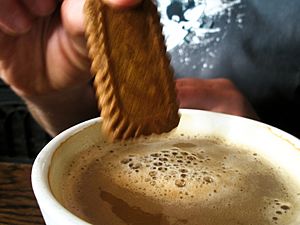
Sweet biscuits are often eaten as a snack. They are usually made with wheat flour or oats and sweetened with sugar or honey. Some varieties have chocolate, fruit, jam, nuts, or ginger.
The digestive biscuit and rich tea are very popular in British culture. They are often eaten with a cup of tea. Some tea drinkers like to "dunk" their biscuits in tea. This lets the biscuit soak up the liquid and become a little soft before they eat it. In 2009, chocolate digestives, Rich tea, and Hobnobs were voted the UK's top three favorite biscuits for dunking.
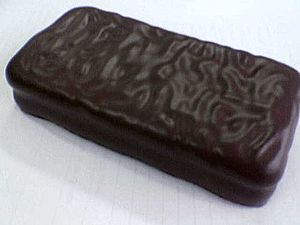
Savoury biscuits or crackers (like cream crackers, water biscuits, oatcakes, or crisp bread) are usually plainer. They are often eaten with cheese after a meal. Many savoury biscuits have extra ingredients for flavor or texture, such as poppy seeds, onion, cheese, or olives. In most European supermarkets, savoury biscuits have their own section, often next to the sweet biscuits.
In many countries like the UK, Australia, South Africa, New Zealand, India, and Ireland, "biscuit" usually means a sweet biscuit. In Canada, the term is used less often, but some imported brands still use it. The American company Nabisco (National Biscuit Company) got its name from this older meaning of "biscuit" for crackers.
In North America
In the United States and parts of Canada, a "biscuit" is a small bread with a firm, browned crust and a soft inside. They are made with baking powder or baking soda to help them rise, instead of yeast. However, some biscuits, called "angel biscuits," do use yeast, or they can be made with a sourdough starter.
Biscuits are traditionally served as a side dish with a meal. For breakfast, they are often eaten with butter and a sweet topping like molasses, maple syrup, honey, or fruit jam. With other meals, they are usually eaten with butter or gravy. However, "biscuits and gravy" (biscuits covered in a creamy gravy) or biscuits with sausage are common breakfast main courses. A biscuit can also be sliced in half to make a breakfast sandwich with eggs or breakfast meat inside.
Images for kids
-
Huntley & Palmers biscuit tin. This company, started in Reading, Berkshire in 1822, became one of the world's first global brands.
-
An 1891 advertisement in London for Peek Freans, a brand exported to Asia.
See also
 In Spanish: Galleta para niños
In Spanish: Galleta para niños



